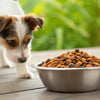Is Dry Dog Food or Wet Dog Food Better? A Comprehensive Guide for Pet Owners
- Houndsy
Table of Contents
- Introduction
- Understanding Dry Dog Food
- Understanding Wet Dog Food
- Mixing Wet and Dry Dog Food
- Factors to Consider When Choosing Dog Food
- The Houndsy Advantage: Elevating Your Feeding Experience
- Conclusion
Introduction
Imagine you're at your local pet store, standing in front of an entire aisle dedicated to dog food. The sheer variety can be overwhelming—brands, flavors, textures—each promising to provide the best nutrition for your furry friend. As responsible pet owners, we often ask ourselves, "Is dry dog food or wet dog food better?" This question is crucial because the type of food we choose can significantly impact our dogs' health, energy levels, and overall well-being.
With around 78% of pet owners considering their pets' diets a top priority, it's no wonder that the wet versus dry food debate remains a hot topic in the pet care community. In this blog post, we will explore the benefits and drawbacks of both dry and wet dog food, helping you make an informed decision tailored to your dog’s specific needs.
By the end, you will have a clearer understanding of what each type of food offers, and we’ll also delve into how our Houndsy Kibble Dispenser can elevate your feeding routine, ensuring that meal times are not only convenient but also enjoyable for both you and your beloved pet.
Understanding Dry Dog Food
What Is Dry Dog Food?
Dry dog food, commonly referred to as kibble, has a lower moisture content—typically ranging from 5% to 10%. This makes it easy to store and measure, as it can be kept in bags without the worry of spoiling quickly. The kibble is created through a process that involves cooking and then extruding a mixture of meat, grains, and other ingredients into small pieces.
Benefits of Dry Dog Food
- Convenience: Dry food is easier to portion and less messy than wet food. It can be left out for longer periods without spoiling, making it ideal for dogs that prefer to graze throughout the day.
- Dental Health: The crunchy texture of kibble can help reduce plaque buildup on your dog's teeth. While dry food won’t replace regular dental care, it can be a beneficial addition to your dog's oral hygiene routine.
- Cost-Effectiveness: Generally, dry food offers more nutritional density per pound compared to wet food. This means you may need to buy less over time, making it a more budget-friendly option.
- Variety in Feeding: Kibble is easier to incorporate into food puzzles and slow feeders, which can enhance cognitive stimulation for your dog.
- Longer Shelf Life: Dry food can be stored for extended periods without the risk of spoiling, as long as it's kept in a cool, dry place.
Drawbacks of Dry Dog Food
- Lower Moisture Content: The low moisture in dry food can be a drawback for dogs that struggle with hydration. It is essential to ensure your dog has access to fresh water at all times.
- Less Palatable for Some Dogs: Some dogs may find dry food less appealing, especially picky eaters or those recovering from illness.
- Potential for Overeating: If not measured carefully, dogs may overeat dry food, leading to weight gain.
Understanding Wet Dog Food
What Is Wet Dog Food?
Wet dog food typically comes in cans or pouches and contains a moisture content ranging from 75% to 85%. It often has a more appealing aroma and texture that closely resembles fresh meat, making it irresistible for many dogs.
Benefits of Wet Dog Food
- Increased Hydration: The high moisture content in wet food is beneficial for dogs that don’t drink enough water, particularly those with urinary or kidney issues.
- Higher Palatability: Dogs often find wet food more appetizing due to its rich aroma and flavor, which can be especially helpful for older dogs or those with decreased appetites.
- Easier to Chew: Wet food is softer and easier to chew, making it ideal for dogs with dental issues or those who have a hard time with kibble.
- Satiety: The moisture in wet food can help dogs feel fuller without increasing calorie consumption, making it a good option for weight management.
Drawbacks of Wet Dog Food
- Cost: Wet food is generally more expensive than dry food, especially if you have a larger breed or multiple dogs.
- Spoilage: Once opened, wet food should be consumed within a few hours or stored in the refrigerator, where it can last for a few days. This can lead to waste if your dog doesn't finish it.
- Dental Health: While wet food is easier to chew, it doesn’t provide the same dental benefits as dry food.
- Storage Space: Canned food takes up more space in your pantry and can be cumbersome to manage.
Mixing Wet and Dry Dog Food
One strategy many pet owners find effective is mixing both wet and dry dog food. This approach allows you to take advantage of the benefits of both types. For example, you could use dry kibble as a base and top it with wet food to enhance flavor and moisture. This not only adds variety to your dog's diet but also ensures they receive balanced nutrition.
Benefits of Mixing
- Enhanced Flavor: Mixing wet food with dry kibble can make meals more appealing, encouraging your dog to eat.
- Balanced Nutrition: Combining the two can ensure your dog receives the right balance of nutrients, hydration, and palatability.
- Customized Feeding: By adjusting the ratio of wet to dry food, you can tailor meals to your dog's specific needs and preferences.
Factors to Consider When Choosing Dog Food
When deciding between dry and wet dog food, consider the following factors:
- Your Dog’s Age and Health: Puppies, adults, and senior dogs have different nutritional needs. Additionally, health issues such as dental problems, obesity, or urinary conditions may influence your choice.
- Personal Lifestyle: Your feeding routine, budget, and storage capabilities should all play a role in your decision.
- Vet Recommendations: Always consult your veterinarian for tailored advice based on your dog's individual health needs.
The Houndsy Advantage: Elevating Your Feeding Experience
Here at Houndsy, we understand that feeding your dog is more than just a routine; it’s a cherished ritual. That’s why we designed the Houndsy Kibble Dispenser, our flagship product that marries modern design with ergonomic convenience. Our dispenser features:
- Convenient Crank: No more bending down to fill bowls. Our standing-height design makes it easy to serve your dog without any hassle.
- Perfect Portion Control: With our innovative dispensing mechanism, you can ensure your dog receives the right amount of food every time, helping to prevent overeating.
- Sleek Design: The mid-century modern aesthetic complements any home decor, making feeding time a stylish affair.
- Large Storage Capacity: With a capacity of 25-30 lbs, our dispenser minimizes trips to the store while keeping your dog’s food fresh with a BPA-free liner.
- Auto-Locking Mechanism: This feature prevents accidental dispensing, keeping curious paws (or little hands) away from the kibble when you're not around.
Feeding your dog should be an enjoyable experience, not a chore. Our Houndsy Kibble Dispenser is designed to enhance that experience, making meal times beautiful and effortless. Ready to elevate your feeding routine? Explore our Houndsy Kibble Dispenser now!
Conclusion
Choosing between dry dog food and wet dog food is a personal decision that depends on various factors, including your dog’s health, preferences, and your lifestyle. Both types offer unique benefits and can play essential roles in your dog's diet.
Ultimately, the best choice is one that ensures your dog receives balanced nutrition while also being enjoyable for them to eat. Whether you opt for dry kibble, wet food, or a combination of both, knowing your options empowers you to make the best decision for your furry companion.
As you fine-tune your dog’s diet, remember that feeding time is a special opportunity for bonding. With the right food and tools, like our Houndsy Kibble Dispenser, you can turn each meal into a delightful ritual for both you and your pet.
FAQ
1. Can I mix dry and wet dog food?
Yes, many pet owners mix both dry and wet food to provide their dogs with a balanced diet. This can enhance flavor and ensure proper hydration.
2. Is wet food better for older dogs?
Wet food can be beneficial for older dogs, especially those with dental issues or decreased appetites, as it is easier to chew and more palatable.
3. How do I know how much to feed my dog?
Consult your veterinarian to determine the appropriate daily caloric intake for your dog based on their age, size, and activity level.
4. Should I switch my dog's food type?
If you are considering switching your dog's food type, make the transition gradually over a week to avoid digestive upset.
5. How can I keep my dog's food fresh?
Dry food should be stored in a cool, dry place, while wet food should be refrigerated after opening and used within a few days.
Discover how our Houndsy Kibble Dispenser can simplify and enhance your pet feeding experience today! Order now!












